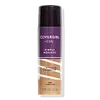Covergirl + Olay Simply Ageless 3-In-1 Liquid Foundation Versus Revlon ColorStay Full Cover Matte Foundation
What's inside
What's inside
 Key Ingredients
Key Ingredients

 Benefits
Benefits

 Concerns
Concerns

 Ingredients Side-by-side
Ingredients Side-by-side

Cyclopentasiloxane
EmollientWater
Skin ConditioningGlycerin
HumectantDimethicone Crosspolymer
Emulsion StabilisingSodium Chloride
MaskingAcetyl Glucosamine
Skin ConditioningDiethylhexyl Carbonate
EmollientNiacinamide
SmoothingEthylhexyl Methoxycinnamate
UV AbsorberTalc
AbrasivePEG/PPG-18/18 Dimethicone
EmulsifyingPanthenol
Skin ConditioningPalmitoyl Pentapeptide-4
Skin ConditioningTocopheryl Acetate
AntioxidantAllantoin
Skin ConditioningMethicone
EmollientAluminum Hydroxide
EmollientBenzyl Alcohol
PerfumingCamellia Sinensis Leaf Extract
AntimicrobialPEG-10 Dimethicone Crosspolymer
StabilisingMethylparaben
PreservativeEthylparaben
PreservativePropylparaben
PreservativeDisodium EDTA
Parfum
MaskingPEG-100 Stearate
Titanium Dioxide
Cosmetic ColorantIron Oxides
Cyclopentasiloxane, Water, Glycerin, Dimethicone Crosspolymer, Sodium Chloride, Acetyl Glucosamine, Diethylhexyl Carbonate, Niacinamide, Ethylhexyl Methoxycinnamate, Talc, PEG/PPG-18/18 Dimethicone, Panthenol, Palmitoyl Pentapeptide-4, Tocopheryl Acetate, Allantoin, Methicone, Aluminum Hydroxide, Benzyl Alcohol, Camellia Sinensis Leaf Extract, PEG-10 Dimethicone Crosspolymer, Methylparaben, Ethylparaben, Propylparaben, Disodium EDTA, Parfum, PEG-100 Stearate, Titanium Dioxide, Iron Oxides
Dimethicone
EmollientIsodecyl Neopentanoate
EmollientWater
Skin ConditioningPEG/PPG-19/19 Dimethicone
EmulsifyingTrisiloxane
Skin ConditioningTrimethylsiloxysilicate
EmollientC13-16 Isoparaffin
SolventMica
Cosmetic ColorantAdipic Acid/Neopentyl Glycol Crosspolymer
Boron Nitride
AbsorbentDimethicone/Bis-Isobutyl PPG-20 Crosspolymer
EmollientC10-13 Isoparaffin
SolventAlumina
AbrasiveButylene Glycol
HumectantCymbidium Grandiflorum Flower Extract
Skin ConditioningDimethicone/Silsesquioxane Copolymer
Disteardimonium Hectorite
StabilisingEthylhexyl Palmitate
EmollientGlycerin
HumectantHydrogen Dimethicone
Lactobacillus/Eriodictyon Californicum Ferment Extract
Skin ConditioningLilium Candidum Bulb Extract
Skin ConditioningMalva Sylvestris Extract
AstringentMethicone
EmollientPolyisobutene
Propylene Carbonate
SolventSalicylic Acid
MaskingSerica
HumectantSilica Dimethyl Silylate
EmollientSilica Silylate
EmollientSodium Acrylates Crosspolymer-2
AbsorbentSorbitan Sesquioleate
EmulsifyingTetrasodium EDTA
Tocopherol
AntioxidantTriethoxycaprylylsilane
1,2-Hexanediol
Skin ConditioningCaprylyl Glycol
EmollientPhenoxyethanol
PreservativeIron Oxides
CI 77891
Cosmetic ColorantTitanium Dioxide
Cosmetic ColorantZinc Oxide
Cosmetic ColorantDimethicone, Isodecyl Neopentanoate, Water, PEG/PPG-19/19 Dimethicone, Trisiloxane, Trimethylsiloxysilicate, C13-16 Isoparaffin, Mica, Adipic Acid/Neopentyl Glycol Crosspolymer, Boron Nitride, Dimethicone/Bis-Isobutyl PPG-20 Crosspolymer, C10-13 Isoparaffin, Alumina, Butylene Glycol, Cymbidium Grandiflorum Flower Extract, Dimethicone/Silsesquioxane Copolymer, Disteardimonium Hectorite, Ethylhexyl Palmitate, Glycerin, Hydrogen Dimethicone, Lactobacillus/Eriodictyon Californicum Ferment Extract, Lilium Candidum Bulb Extract, Malva Sylvestris Extract, Methicone, Polyisobutene, Propylene Carbonate, Salicylic Acid, Serica, Silica Dimethyl Silylate, Silica Silylate, Sodium Acrylates Crosspolymer-2, Sorbitan Sesquioleate, Tetrasodium EDTA, Tocopherol, Triethoxycaprylylsilane, 1,2-Hexanediol, Caprylyl Glycol, Phenoxyethanol, Iron Oxides, CI 77891, Titanium Dioxide, Zinc Oxide
 Reviews
Reviews

Ingredients Explained
These ingredients are found in both products.
Ingredients higher up in an ingredient list are typically present in a larger amount.
Glycerin is already naturally found in your skin. It helps moisturize and protect your skin.
A study from 2016 found glycerin to be more effective as a humectant than AHAs and hyaluronic acid.
As a humectant, it helps the skin stay hydrated by pulling moisture to your skin. The low molecular weight of glycerin allows it to pull moisture into the deeper layers of your skin.
Hydrated skin improves your skin barrier; Your skin barrier helps protect against irritants and bacteria.
Glycerin has also been found to have antimicrobial and antiviral properties. Due to these properties, glycerin is often used in wound and burn treatments.
In cosmetics, glycerin is usually derived from plants such as soybean or palm. However, it can also be sourced from animals, such as tallow or animal fat.
This ingredient is organic, colorless, odorless, and non-toxic.
Glycerin is the name for this ingredient in American English. British English uses Glycerol/Glycerine.
Learn more about GlycerinMethicone is a type of silicone and is a simpler form of dimethicone.
Silicones are used to enhance the texture of products and have emollient properties. Methicone is used to give products a silky texture and improves spreadability.
Titanium dioxide is a mineral UV filter widely used in sunscreens and cosmetics.
It is one of only two UV filters officially classified as “mineral” by regulatory agencies, the other being zinc oxide.
Titanium dioxide provides broad-spectrum protection mostly in the UVB and UVAII range, with some protection in the UVAI range.
While its UVA protection isn’t as strong as zinc oxide’s, the difference is minor.
A common myth is that mineral UV filters reflect UV light. However, modern research shows titanium dioxide absorbs UV radiation like chemical filters (~95% absorption & 5% reflection).
Thanks to its non-irritating nature, titanium dioxide is suitable for sensitive, acne-prone, or redness-prone skin. It is unlikely to cause "eye sting" like other sunscreen ingredients.
A major drawback of this ingredient is its white cast and thick texture. This is why mineral sunscreens often leave a white cast and are less cosmetically elegant than chemical/hybrid sunscreens.
To improve white cast and spreadability, micronized or nano-sized titanium dioxide is often used.
There are ongoing concerns surrounding nano-titanium oxide's impact on marine ecosystems.
There is no conclusive evidence that any form of titanium oxide (or any other sunscreen ingredients) will cause harm to marine ecosystems or coral reefs. The science is still developing but many consumers are keeping a close eye on this issue.
Please note, many destinations have reef-safety sunscreen rules. For instance, the U.S. Virgin Islands advises all visitors to use non-nano mineral sunscreens.
Nano mineral sunscreens once raised safety concerns about absorption into skin.
Extensive research has shown that they do not penetrate healthy or damaged skin; they remain safely on the surface and the top layer of dead skin (stratum corneum).
You'll likely find titanium dioxide bundled with alumina, silica, or dimethicone. These ingredients help make titanium dioxide highly photostable; this prevents it from interacting with other formula components under UV light.
Learn more about Titanium DioxideWater. It's the most common cosmetic ingredient of all. You'll usually see it at the top of ingredient lists, meaning that it makes up the largest part of the product.
So why is it so popular? Water most often acts as a solvent - this means that it helps dissolve other ingredients into the formulation.
You'll also recognize water as that liquid we all need to stay alive. If you see this, drink a glass of water. Stay hydrated!
Learn more about WaterThis ingredient is a combination of red, black, and yellow iron oxide pigments. This combination of colors is usually found in foundation, because it results in a "skin" color.